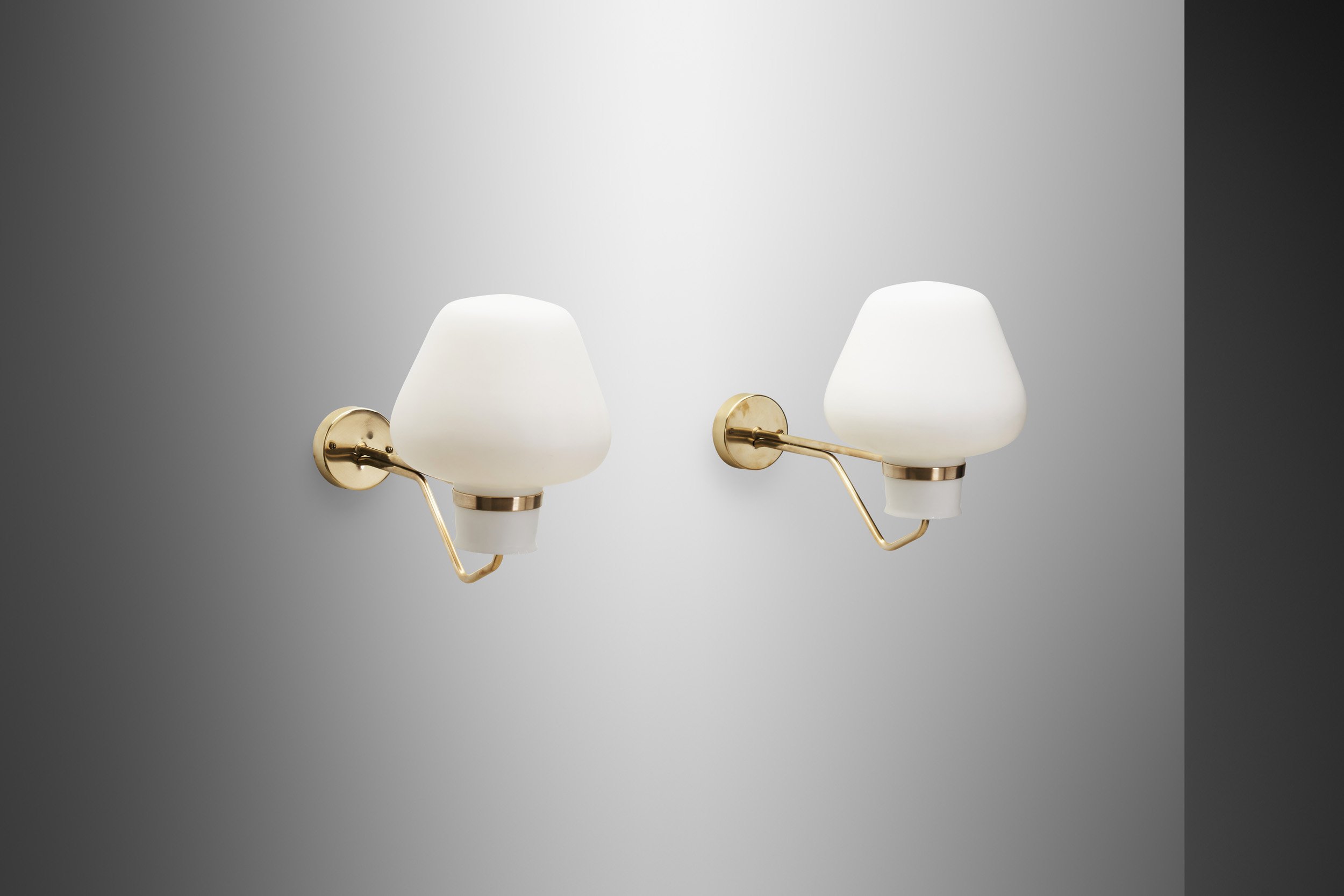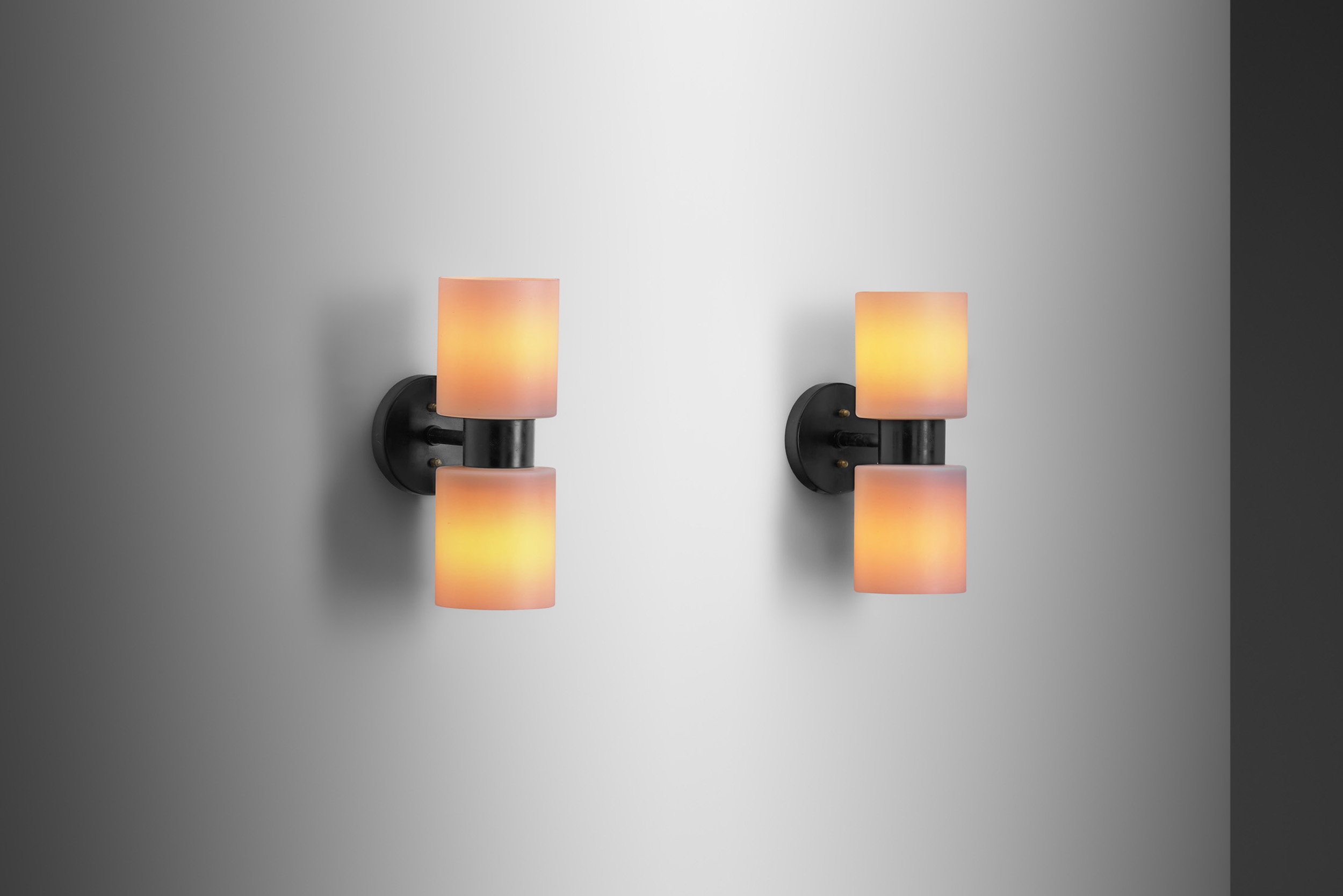Large Opaline Glass and Brass Wall Lamps by Erik Gunnar Asplund for ASEA, Sweden 1940s

















Large Opaline Glass and Brass Wall Lamps by Erik Gunnar Asplund for ASEA, Sweden 1940s
REQUEST PRICE HERE
Price category: 5,000 - 7,500 usd / eur
In the annals of mid-century modern design, the Swedish designer and architect, Gunnar Asplund stood out as a luminary, and his delicately sculptural creations, such as this pair of wall lamps from the 1950s, epitomize the era's sophistication and functional beauty. Swedish architect and designer, Erik Gunnar Asplund is celebrated as the godfather of functionalist design in Sweden. Asplund's meticulous attention to detail and penchant for marrying form with function is evident in these wall lamps, combining materials just as ingeniously as forms and shapes.
Crafted in the 1950s, these wall lamps feature circular brass mounts that gracefully extend two brass arms, holding both the light bulbs and the large, sculptural opaline glass diffusers. The geometric precision of the design reflects Asplund's architectural background, where clean lines and balanced proportions reign supreme. The lamps serve as great examples of the enduring quality of mid-century Swedish craftsmanship. Swedish mid-century modern design, marked by its emphasis on simplicity and functionality, sought to bring beauty into everyday life. Asplund's pieces encapsulate this ethos, transcending mere utilitarianism to become objets d'art that enhance living spaces. Manufactured by ASEA, a Swedish powerhouse in electrical engineering and industrial design, these lamps embody the marriage of aesthetics and utility. ASEA, founded in 1883, played a pivotal role in shaping Sweden's industrial landscape. Their foray into lighting design seamlessly blended technological innovation with artistic sensibility, making them a prominent player in the mid-century modern movement. The choice of brass and opaline glass as primary materials in these lamps speaks to the enduring appeal of this combination in mid-century modern lighting design. Brass, with its warm and timeless lustre, complements the opulence of mid-century interiors, while opaline glass diffusers disperse light with a soft, ethereal glow. This harmonious pairing endures as a hallmark of sophistication, blending seamlessly into contemporary design aesthetics.
Swedish lighting design, deeply rooted in the country's commitment to quality craftsmanship and functional elegance, continues to influence global trends. The enduring popularity of mid-century modern design, exemplified by these Erik Gunnar Asplund lamps, underscores their timeless allure. These wall lamps, with their graceful silhouette and impeccable construction, stand as prime examples behind the enduring legacy and popularity of Swedish design excellence in the world of lighting design.
Condition:
In good vintage condition. Wear consistent with age and use. The brass structures have some light marks and scratches. Some irregularities in the cups.
Dimensions:
10.62 in W x 21.25 in D x 11.02 in H
27 cm W x 54 cm D x 28 cm H
About the designer:
Erik Gunnar Asplund (22 September 1885 – 20 October 1940) was a Swedish architect, mostly known as a key representative of Nordic Classicism of the 1920s, and during the last decade of his life as a major proponent of the modernist style which made its breakthrough in Sweden at the Stockholm International Exhibition in 1930. Asplund was professor of architecture at the Royal Institute of Technology from 1931. His appointment was marked by a lecture, later published under the title "Our architectonic concept of space." The Woodland Crematorium at Stockholm South Cemetery (1935-1940) is considered his finest work and one of the masterpieces of modern architecture.
Born in Stockholm, Erik Gunnar Asplund occupies a central position in the development of Scandinavian architecture and design of the twentieth century. He is considered the archetype of the generation that gave rise to the maturing process of the above estates, subsequently developed by such figures as Alvar Aalto, Erik Bryggman, Arne Jacobsen, Jørn Utzon. After graduating as an architect in 1909, many trips to Europe and the United States punctuated his apprenticeship. His works from the years 1911 to 1930, influenced by a strong romantic tradition, express a neoclassical language, founded on vernacular cultural bases. Another important work is the extension of the Gothenburg City Hall Extension building which Asplund started in 1913 and finished 1937 - it shows his transformation from Neoclassical to functionalist architect, a transformation in parallel with other European modernists like Erich Mendelsohn.
In terms of decoration and design his most notable works are: his furniture, particularly his lighting designs; the study of popular housing for the exhibition of the Swedish Society of "Arts and Crafts" (1917); interior design for the "Art and Industry" association, Stockholm (1920); the decoration and furniture of the City Hall, Stockholm (1921); some furniture models dating back to 1931, such as the famous judge's chair and the furnishings of the Lister Sölvesborg courthouse; the decoration of the Swedish pavilion at the Paris Exposition (1925); decoration and objects created for the Stockholm Municipal Library (1920-28); the Council Room at the Headquarters of the Arts and Crafts Association (1931); and the decoration for the Palace of Justice and for the Town Hall, Gothenburg (1916-37).
Gunnar Asplund is considered perhaps the most important modernist Swedish architect and has had a major influence on later generations of Swedish and Nordic architects.






